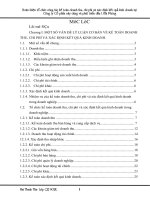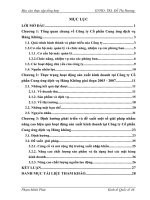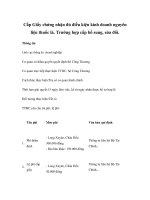Kỹ Năng Viết Trong Kinh Doanh (Tài liệu tiếng anh)
Bạn đang xem bản rút gọn của tài liệu. Xem và tải ngay bản đầy đủ của tài liệu tại đây (4.8 MB, 47 trang )
Business Writing Skills
SPIN INTERVIEW FRAMEWORK
Learning Objectives
What is Business Communication
2
Types of Communication
3
STAR Format of Written Communication
4
Essentials of Effective Communication
5
Tips for Smart Communication
6
Communication across cultures
7
Exercises
8
Summary
REC
P
STO
##
1
PLAY
What is Business Communication?
Let’s first understand what is communication...
Communication is transferring information and understanding from one to one or one to many. It could take place in a verbal or a
##
written mode and could use forms such as face-to-face meetings, group discussions, e-mail writing, and even non verbal modes like
gestures, body language, etc.
Message
CHANNEL
Message
SENDER
DECODING
Message
RECEIVER
FEEDBACK
What is Business Communication?
Business Communication is any communication that involves
communicating for business / official purpose to achieve a
predetermined objective. This may include:
CVs, Resumes
Email, Web site, FAQs
Letters, Newsletters, Brochures,
##
Articles, Catalogs
Advertisements, Notice Board,
Pamphlets, Signs, Press Releases
Presentations, multimedia, talks
Reports, Manuals, Proposals,
Books
SPIN INTERVIEW FRAMEWORK
Learning Objectives
What is Business Communication
2
Types of Communication
3
STAR Format of Written Communication
4
Essentials of Effective Communication
5
Tips for Smart Communication
6
Communication across cultures
7
Exercises
8
Summary
REC
P
STO
##
1
PLAY
Types of Communication
Types of Communication
Verbal
Communication
##
Written
Verbal
Non Verbal
Written
Non
Verbal
Types of Communication
Verbal Communication
•
•
Communication
Provides instant feedback
Opportunity to check for
understanding
•
Involves Questioning &
Paraphrasing
Faster closure on open
##
•
items
•
No record unless minutes
of the meeting recorded
•
•
Usually unstructured
Increases speed of
communication
Verbal
Written
Non
Verbal
Types of Communication
Written Communication
•
Provides record for future
Communication
reference
•
•
More structured
Tools to gain attention – like
bullets, bold, etc.
Ability to provide details
Can be sent to multiple
##
•
•
people at the same time
•
•
More Formal
It mainly consists of
diagrams, pictures, graphs,
reports, policies, rules,
orders, instructions,
agreements, etc.
•
Comprehensive & Accurate
Verbal
Written
Non
Verbal
Types of Communication
Non Verbal Communication
•
Constitutes of Physical,
Communication
Aesthetic, Signs, Symbolic
•
Complements Verbal
Communication - It may accent
or underline a verbal message.
Pounding the table, for
##
example, can underline a
message.
•
•
•
Gestures talk more than words
Could be Positive / Negative
Indicative of a person’s
personality
Verbal
Written
Non
Verbal
SPIN INTERVIEW FRAMEWORK
Learning Objectives
What is Business Communication
2
Types of Communication
3
STAR Format of Written Communication
4
Essentials of Effective Communication
5
Tips for Smart Communication
6
Communication across cultures
7
Exercises
8
Summary
REC
P
STO
##
1
PLAY
STAR Format of Written Communication
1. Analyze
the
Purpose
2. Consider the
Audience
5. Execute with
Confidence
STAR / ACBDE Model of Communication
4. Detail &
3. Build the
Design
Structure
Approach
STAR Format of Written Communication
1.
Analyze the Purpose
Before you begin writing:
What is the purpose of writing the mail / letter / memo / etc.?
What information do you wish to exchange?
What does your reader want to know?
What action do you want the reader to take?
##
•.
•.
•.
•.
•.
What relationship do you have with the reader?
If you can’t answer these questions, then you should wonder, whether
you should even the send the communication.
STAR Format of Written Communication
1.
Analyze the Purpose
Subject of the Mail
•.
•.
Subject should convey the purpose
Subject field is the first thing reader will see before opening the
communication sent
Subject field of your message should be meaningful
##
•.
•.
Subject field [when you use the ‘reply’ option in case of e-mails]
should accurately reflect the content of the message
•.
Subject should be brief - Does not need to be a complete
sentence
STAR Format of Written Communication
1. Analyze
the
Purpose
2. Consider the
Audience
5. Execute with
Confidence
STAR / ACBDE Model of Communication
4. Detail &
3. Build the
Design
Structure
Approach
STAR Format of Written Communication
2. Consider the Audience
Recipients & Gender Bias
•
Write the name of the person that you are writing to, in the ‘To’
field
•
Write the name of the person / persons you want to be
informed about the contents of the mail in the ‘Cc’ field
Do not write names in the ‘Bcc’ field
##
•
•
•
Avoid using he / she repeatedly.
Write sentences in the plural
For example, “A vendor should give all his details for setting up
the database.” can be changed to “Vendors should give all their
details for setting up the database.”
STAR Format of Written Communication
1. Analyze
the
Purpose
2. Consider the
Audience
5. Execute with
Confidence
STAR / ACBDE Model of Communication
4. Detail &
3. Build the
Design
Structure
Approach
STAR Format of Written Communication
3. Build the Structure
1. Salutation
2. Content
3. Closing
Structure of Written
Communication
STAR Format of Written Communication
3. Build the Structure
Salutation
•
Write to the reader as you would talk to him / her naturally - If
you address John Smith as John in person, do not address him as
Mr. Smith in your email, however, memos / circulars are more
formal and hence require Mr. / Miss.
##
•
•
Use first names - Hi Chris …
Avoid “Good Morning” or “Good Afternoon” as your
communication might reach late / different time zone
STAR Format of Written Communication
3. Build the Structure
Content
Don’ts
Do’s
Mention any specific information that is
requested by the reader - If you cannot
answer a question or provide definite
х
х
the query.
tell as much as you know / offer
additional information when available.
Use Positive statements
For e.g. “This report discusses each step briefly.”
Content should be accurate & crisp
Negative statements - Don’t tell them
they have the information
state when you can send the information.
explain why you won’t be able to answer
do... tell them what can be done
something negative unless it is important that
information:
Don’t tell the reader what you or they can’t
For e.g. “ This report never goes into any
phase of the matter in detail, but covers each
part briefly.”
х
Don’t use casual language – Business
communication is always formal & organized
STAR Format of Written Communication
3. Build the Structure
Closing
•
The final paragraph of a written business communication states
what you want the person to do
•
•
Give timelines
Signoff with your name and contact details in case of any
##
questions / clarifications
•
Do not say ‘thanks in advance/ anticipation. If you would like to
thank someone for their help. Do it after the job. Say ‘ I
appreciate your help’. Or ‘Thanks for the quick response’
•
Close on a pleasant note
STAR Format of Written Communication
1. Analyze
the
Purpose
2. Consider the
Audience
5. Execute with
Confidence
STAR / ACBDE Model of Communication
4. Detail &
3. Build the
Design
Structure
Approach
4. Detail & Design Approach
Components of Detail
& Design
Punctuation
Formatting
•
•
•
•
All letters should be Arial - size 10 / 12
Inappropriate use of punctuation could change the
meaning of the sentence
•
Use line spacing set in the template
Separate paragraphs with one blank line in
Paragraphing
•
between
Keep one main idea per paragraph
•
•
Use short paragraphs
Ideas in successive paragraphs can be
related
It makes the communication look more structured
& clear
STAR Format of Written Communication
4. Detail & Design Approach
More on Punctuation
•
A Period marks the end of a sentence. For e.g.
I believe the changes have been made. Have we tested them to see if the data is
##
following the assignment rules?
•.
A period is used in abbreviations of words.
Company - Co. or miscellaneous – misc.
STAR Format of Written Communication
4. Detail & Design Approach
More on Punctuation
•
Use a Comma to separate a phrase which precedes the main sentence.
•
•
I will come for the party, however, I shall leave early.
Use a comma to set off linking words.
Request the client for the check number. Then, go to the fleet window and
##
•
get the copies.
•
Examples of linking words - However, Moreover, Therefore, Nevertheless, Thereby.
STAR Format of Written Communication
4. Detail & Design Approach
More on Punctuation
•
The Colon “announces” that a list is about to follow; it is the gateway to that list. It
means : ‘As follows’
1.
The requirements for this position are:
•
A degree in Accounts or Economics
##
•
•
Sound financial background
The Apostrophe is used to:
1.
Show possession
•
2.
Anu’ s case studies
Show contractions [not acceptable in formal writing]
•
It’ll [It will]









